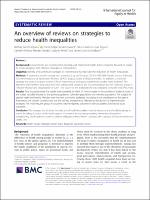| dc.contributor.author | Garzón-Orjuela, Nathaly | |
| dc.contributor.author | Samacá-Samacá, Daniel Felipe | |
| dc.contributor.author | Luque Angulo, Silvia Catalina | |
| dc.contributor.author | Mendes Abdala, Carmen Verônica | |
| dc.contributor.author | Reveiz, Ludovic | |
| dc.contributor.author | Eslava-Schmalbach, Javier | |
| dc.date.accessioned | 2021-11-10T04:12:47Z | |
| dc.date.available | 2021-11-10T04:12:47Z | |
| dc.date.issued | 2020-12 | |
| dc.identifier.issn | 1475-9276 | |
| dc.identifier.uri | https://resources.equityinitiative.org/handle/ei/242 | |
| dc.description.abstract | Background: Governments are incentivized to develop and implement health action programs focused on equity to ensure progress with effective strategies or interventions. Objective: Identify and synthesize strategies or interventions that facilitate the reduction of health inequalities. Methods: A systematic search strategy was carried out up until August 2019 in MEDLINE (Ovid), Embase (Elsevier), Cochrane Database of Systematic Reviews, LILACS, Scopus, Scielo and Epistemonikos. In addition, a snowball strategy was used. Literature reviews (LRs) of experimental and quasi-experimental studies were included. The identified interventions and outcomes were categorized based on the recommendation by the Cochrane group in “Effective Practice and Organization of Care”. The quality of the included LRs was evaluated using the AMSTAR 2 tool. Results: Four thousand ninety-five articles were identified, of which 97 were included in the synthesis of evidence. Most of the studies included focused on the general population, vulnerable populations and minority populations. The subjects of general health and healthy lifestyles were the most commonly addressed. According to the classification of the type of intervention, the domain covered most was the delivery arrangements, followed by the domain of implementation strategies. The most frequent group of outcomes was the reported outcome in (clinical) patients, followed by social outcomes. Conclusion: The strategies that facilitate the reduction of health inequalities must be intersectoral and multidisciplinary in nature, including all sectors of the health system. It is essential to continue generating interventions focused on strengthening health systems in order to achieve adequate universal health coverage, with a process of comprehensive and quality care. | |
| dc.format.extent | 192 | |
| dc.format.mimetype | application/pdf | |
| dc.language.iso | en | |
| dc.rights | © The Author(s). 2020 | |
| dc.subject | Health equity | |
| dc.subject | Strategies | |
| dc.subject | Health status disparities | |
| dc.subject | Systematic review | |
| dc.title | An overview of reviews on strategies to reduce health inequalities | |
| mods.genre | journalArticle | |
| schema.audience | Fellows | |
| dc.identifier.doi | 10.1186/s12939-020-01299-w | |

